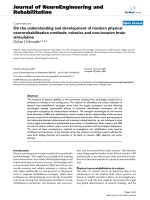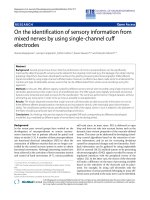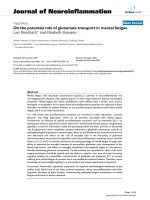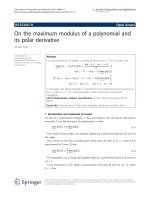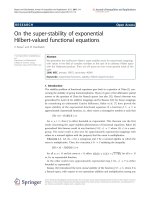Báo cáo hóa học: " On the behavior of solutions of the system of rational difference equations" pptx
Bạn đang xem bản rút gọn của tài liệu. Xem và tải ngay bản đầy đủ của tài liệu tại đây (255.31 KB, 8 trang )
RESEARC H Open Access
On the behavior of solutions of the system of
rational difference equations
x
n+1
=
x
n−1
y
n
x
n−1
− 1
, y
n+1
=
y
n−1
x
n
y
n−1
− 1
, z
n+1
=
1
y
n
z
n
Abdullah Selçuk Kurbanli
Correspondence: akurbanli@yahoo.
com
Department Of Mathematics,
Faculty Of Education, Selcuk
University, Konya 42090, Turkey
Abstract
In this article, we investigate the solut ions of the system of difference equations
y
n+1
=
y
n−1
x
n
y
n−1
− 1
,
y
n+1
=
y
n−1
x
n
y
n−1
− 1
,
z
n+1
=
1
y
n
z
n
where x
0
, x
-1
, y
0
, y
-1
, z
0
, z
-1
real
numbers such that y
0
x
-1
≠ 1, x
0
y
-1
≠ 1 and y
0
z
0
≠ 0.
1. Introduction
In [1], Kurbanli et al. studied the behavior of positive solutions of the system of
rational difference equations
x
n+1
=
x
n−1
y
n
x
n−1
+1
, y
n+1
=
y
n−1
x
n
y
n−1
+1
.
In [2], Cinar studied the solutions of the systems of difference equations
x
n+1
=
1
y
n
, y
n+1
=
y
n
x
n−1
y
n−1
.
In [3], Kurban li, studied the behavior of solutions of the system of rational difference
equations
x
n+1
=
x
n−1
y
n
x
n−1
− 1
, y
n+1
=
y
n−1
x
n
y
n−1
− 1
, z
n+1
=
z
n−1
y
n
z
n−1
− 1
.
In [4], Papaschinnopoulos and Schinas proved the boundedness, persistence, the
oscillatory behavior, and the asymptotic behavior of the positive solutions of the system
of difference equations
x
n+1
=
k
i
=
0
A
i
/y
p
i
n−i
, y
n+1
=
k
i
=
0
B
i
/x
q
i
n−
i
In [5], Clark and Kulenović investigate the global stability properties and asymptotic
behavior of solutions of the system of difference equations
x
n+1
=
x
n
a + c
y
n
, y
n+1
=
y
n
b + dx
n
.
In [6], Camouzis and Papaschinnopoulos studied the global asymptotic behavior of
positive solutions of the system of rational difference equations
Kurbanli Advances in Difference Equations 2011, 2011:40
/>© 2011 K urbanli; licensee Springer. This is an Open Access a rticle distributed under the terms of the Creative Common s Attribution
License ( which permits unrestricted use, distribution, and reproduction in any medium,
provided the original work is properly cited.
x
n+1
=1+
x
n
y
n−m
, y
n+1
=1+
y
n
x
n−m
.
In [7], Kulenović and Nurkanović studied the global asymptotic behavio r of solutions
of the system of difference equations
x
n+1
=
a + x
n
b +
y
n
, y
n+1
=
c + y
n
d + z
n
, z
n+1
=
e + z
n
f
+ x
n
.
In [8], Özban studied the positive solutions of the system of rational difference equa-
tions
x
n+1
=
1
y
n−k
, y
n+1
=
y
n
x
n−m
y
n−m−k
.
In [9], Zhang et al. investigated the behavior of the positive solutions of the system
of the difference equations
x
n
= A +
1
y
n−
p
, y
n
= A +
y
n−1
x
n−r
y
n−s
.
In [10], Yalcinkaya studied the global asymptotic stability of the system of difference
equations
z
n+1
=
t
n
z
n−1
+ a
t
n
+ z
n
−1
, t
n+1
=
z
n
t
n−1
+ a
z
n
+ t
n
−1
In [11], Irićanin and Stević studied the positive solutions of the system of difference
equations
x
(1)
n+1
=
1+x
(2)
n
x
(3)
n−1
, x
(2)
n+1
=
1+x
(3)
n
x
(4)
n−1
, , x
(k)
n+1
=
1+x
(1)
n
x
(2)
n−1
,
x
(1)
n+1
=
1+x
(2)
n
+ x
(3)
n−1
x
(4)
n
−2
, x
(2)
n+1
=
1+x
(3)
n
+ x
(4)
n−1
x
(5)
n
−2
, , x
(k)
n+1
=
1+x
(1)
n
+ x
(2)
n−1
x
(3)
n
−2
Although difference equations are very simple in form, it is extremely difficult to
understand throughly the global behavior of their solutions, for example, see Refs.
[12-34].
In this article, we investigate the behavior of the sol utions of the diff erence equation
system
x
n+1
=
x
n−1
y
n
x
n−1
− 1
, y
n+1
=
y
n−1
x
n
y
n−1
− 1
, z
n+1
=
1
y
n
z
n
(1:1)
where x
0
, x
-1
, y
0
, y
-1
, z
0
, z
-1
real numbers such that y
0
x
-1
≠ 1, x
0
y
-1
≠ 1 and y
0
z
0
≠ 0.
2. Main results
Theorem 1. Let y
0
= a, y
-1
= b, x
0
= c, x
-1
= d, z
0
= e, z
-1
= f be real numbers such that
y
0
x
-1
≠ 1, x
0
y
-1
≠ 1 and y
0
z
0
≠ 0. Let {x
n
, y
n
, z
n
} be a solution of the system (1.1). Then
all solutions of (1.1) are
x
n
=
d
(
ad − 1
)
n
, n −−−odd c (cb − 1)
n
, n −−−eve
n
(1:2)
Kurbanli Advances in Difference Equations 2011, 2011:40
/>Page 2 of 8
y
n
=
b
(
cb − 1
)
n
, n −−−odd a ( ad − 1)
n
, n −−−eve
n
(1:3)
z
n
=
⎧
⎨
⎩
b
n
−1
a
n
e
[
(ad−1)(cd−1)
]
k
i=1
i
, n −−−odd
ane(ad−1)
k
i=1
(i−1)
(cb−1)
k
i=1
i
b
n
, n −−−eve
n
(1:4)
Proof. For n = 0, 1, 2, 3, we have
x
1
=
x
−1
y
0
x
−1
− 1
=
d
ad − 1
,
y
1
=
y
−1
x
0
y
−1
− 1
=
b
cb − 1
,
z
1
=
1
y
0
z
0
=
1
ae
,
x
2
=
x
0
y
1
x
0
− 1
=
c
b
cb−1
c − 1
= c(cb − 1),
y
2
=
y
0
x
1
y
0
− 1
=
a
d
ad−1
a − 1
= a(ad − 1)
z
2
=
1
y
1
z
1
=
1
b
cb−1
1
ae
=
(cb − 1)ae
b
,
x
3
=
x
1
y
2
x
1
− 1
=
d
ad−1
a
(
ad − 1
)
d
ad−1
− 1
=
d
(ad − 1)
2
,
y
3
=
y
1
x
2
y
1
− 1
=
b
cb−1
c
(
cb − 1
)
b
cb−1
− 1
=
b
(cb − 1)
2
,
z
3
=
1
y
2
z
2
=
1
a(ad − 1)
(cb−1)ae
b
=
b
a
2
e(ad − 1)(cb − 1)
for n = k, assume that
x
2k−1
=
x
2k−3
y
2k−2
x
2k−3
− 1
=
d
(ad − 1)
k
,
x
2k
=
x
2k−2
y
2k−1
x
2k−2
− 1
= c(cb − 1)
k
,
y
2k−1
=
y
2k−3
x
2k−2
y
2k−3
− 1
=
b
(cb − 1)
k
,
y
2k
=
y
2k−2
x
2k−1
y
2k−2
− 1
= a(ad − 1)
k
and
z
2k−1
=
b
k
−1
a
k
e[(ad − 1)(cb − 1)]
k
i=1
i
,
z
2k
=
a
k
e(ad − 1)
k
i=1
(i−1)
(cb − 1)
k
i=1
i
b
k
are true. Then, for n = k + 1 we will show that (1.2), (1.3), and (1.4) are true. From
(1.1), we have
Kurbanli Advances in Difference Equations 2011, 2011:40
/>Page 3 of 8
x
2k+1
=
x
2k−1
y
2k
x
2k−1
− 1
=
d
(ad−1)
k
a
(
ad − 1
)
k
d
(ad−1)
k
− 1
=
d
(ad − 1)
k+1
,
y
2k+1
=
y
2k−1
x
2k
y
2k−1
− 1
=
b
(cb−1)
k
c
(
cb − 1
)
k
b
(
cb−1
)
k
− 1
=
b
(cb − 1)
k+1
.
Also, similarly from (1.1), we have
z
2k+1
=
1
y
2k
z
2k
=
1
a
(
ad − 1
)
k
a
k
e(ad−1)
k
i=1
(i−1)
(cb−1)
k
i=1
i
b
k
=
b
k
a
k+1
e
(
ad − 1
)
k
i=1
i
(
cb − 1
)
k
i=1
i
.
Also, we have
x
2k+2
=
x
2k
y
2k+1
x
2k
− 1
=
c
(
cb − 1
)
k
b
(cb−1)
k+1
c(cb − 1)
k
− 1
=
c
(
cb − 1
)
k
b
(cb−1)
c − 1
= c(cb − 1)
k+1
,
y
2k+2
=
y
2k
x
2k+1
y
2k
− 1
=
a
(
ad − 1
)
k
d
(
ad−1
)
k+1
a(ad − 1)
k
− 1
=
a
(
ad − 1
)
k
d
(ad−1)
a − 1
= a(ad − 1)
k+
1
and
z
2k+2
=
1
y
2k+1
z
2k+1
=
1
b
(cb−1)
k+1
b
k
a
k+1
e(ad−1)
k
i=1
i
(cb−1)
k
i=1
i
=
a
k+1
e(ad − 1)
k
i=1
i
(cb − 1)
k+1
i=1
i
b
k+1
=
a
k+1
e(ad − 1)
k+1
i=1
(i−1)
(cb − 1)
k+1
i=1
i
b
k+1
.
□
Corollary 1. Let {x
n
, y
n
, z
n
} be a solution of the syst em (1.1). Let a, b, c, d, e, f be real
numbe rs such that ad ≠ 1, cb ≠ 1, ae ≠ 0 and b ≠ 0. Also, if ad, cb Î (1, 2) and b > a
then we have
lim
n
→∞
x
2n−1
= lim
n
→∞
y
2n−1
= lim
n
→∞
z
2n−1
=
∞
and
lim
n
→∞
x
2n
= lim
n
→∞
y
2n
= lim
n
→∞
z
2n
=0
.
Proof. From ad, cb Î (1, 2) and b>awe have 0 <ad -1 < 1 and 0 <cb -1<1.
Hence, we obtain
lim
n→∞
x
2n−1
= lim
n→∞
d
(ad − 1)
n
= d lim
n→∞
1
(ad − 1)
n
= d. ∞ =
−∞, d < 0
+∞, d > 0
,
lim
n→∞
y
2n−1
= lim
n→∞
b
(
cb − 1
)
n
= b lim
n→∞
1
(
cb − 1
)
n
= b. ∞ =
−∞, b < 0
+∞, b > 0
Kurbanli Advances in Difference Equations 2011, 2011:40
/>Page 4 of 8
and
lim
n→∞
z
2n−1
= lim
n→∞
b
n−
1
a
n
e [
(
ad − 1
)(
cb − 1
)
]
k
i=1
i
=
1
e
. ∞ =
−∞, e <
0
+∞, e > 0
Similarly, from ad, cb Î (1, 2) and b>a, we have 0 <ad - 1 < 1 and 0 <cb -1<1.
Hence, we obtain
lim
n→∞
x
2n
= lim
n→∞
c(cd − 1)
n
= c lim
n→∞
(cd − 1)
n
= c.0=0,
lim
n→∞
y
2n
= lim
n→∞
a (af − 1)
n
= a lim
n→∞
(af − 1)
n
= a.0=0
.
and
lim
n→∞
z
2n
= lim
n→∞
a
n
e(ad − 1)
k
i=1
(i−1)
(cb − 1)
k
i=1
i
b
n
=0.e.0=0
.
□
Corollary 2. Let {x
n
, y
n
, z
n
} be a solution of the syst em (1.1). Let a, b, c, d, e, f be real
numbers such that ad ≠ 1, cb ≠ 1, ae ≠ 0 and b ≠ 0. If a = bandcb= ad =2then we
have
lim
n→∞
x
2n−1
= d,
lim
n→∞
y
2n−1
= b,
lim
n→∞
z
2n−1
=
1
ae
and
lim
n→∞
x
2n
= c,
lim
n→∞
y
2n
= a,
lim
n
→∞
z
2n
= e.
Proof.Froma = b and cb = ad =2thenwehave,cb -1=ad - 1 = 1. Hence , we
have
lim
n
→∞
(cb − 1)
n
=
1
and
lim
n
→∞
(ad − 1)
n
=1
.
Also, we have
lim
n→∞
x
2n−1
= lim
n→∞
d
(ad − 1)
n
= d lim
n→∞
1
(ad − 1)
n
= d.1=d
,
lim
n→∞
y
2n−1
= lim
n→∞
b
(
cb − 1
)
n
= b lim
n→∞
1
(
cb − 1
)
n
= b.1=b
and
lim
n→∞
z
2n−1
= lim
n→∞
b
n−
1
a
n
e[(ad − 1)(cb − 1)]
K
i=1
i
= lim
n→∞
1
ae
b
n−
1
a
n−1
[
(
ad − 1
)(
cb − 1
)
]
k
i=1
i
=
1
ae
.
Kurbanli Advances in Difference Equations 2011, 2011:40
/>Page 5 of 8
Similarly, we have
lim
n→∞
x
2n
= lim
n→∞
c(cb − 1)
n
= c lim
n→∞
(cb − 1)
n
= c.1=c,
lim
n
→∞
y
2n
= lim
n
→∞
a(ad − 1)
n
= a lim
n
→∞
(ad − 1)
n
= a.1=a
.
and
lim
n→∞
z
2n
= lim
n→∞
a
n
e(ad − 1)
k
i=1
(i−1)
(cb − 1)
k
i=1
i
b
n
=1.e = e
.
□
Corollary 3. Let {x
n
, y
n
, z
n
} be a solution of the syst em (1.1). Let a, b, c, d, e, f be real
numbers such that ad ≠ 1, cb ≠ 1, ae ≠ 0 and b ≠ 0. Also, if 0<a, b, c, d, e, f <1then
we have
lim
n
→∞
x
2n
= lim
n
→∞
y
2n
= lim
n
→∞
z
2n
=
0
and
lim
n
→∞
x
2n−1
= lim
n
→∞
y
2n−1
= lim
n
→∞
z
2n−1
= ∞
.
Proof. From 0 <a, b, c, d, e, f < 1 we have -1 <ad -1<0and-1<cb - 1 < 0. Hence,
we obtain
lim
n→∞
x
2n
= lim
n→∞
c(bc − 1)
n
= c lim
n→∞
(bc − 1)
n
= c.0=0,
lim
n→∞
y
2n
= lim
n→∞
a(ad − 1)
n
= a lim
n→∞
(ad − 1)
n
= a.0=
0
and
lim
n→∞
z
2n
= lim
n→∞
a
n
e(ad − 1)
k
i=1
(i−1)
(cb − 1)
k
i=1
i
b
n
= e.0=0
.
Similarly, we have
lim
n→∞
x
2n−1
= lim
n→∞
d
(ad − 1)
n
= d lim
n→∞
1
(ad − 1)
n
= d lim
n→∞
1
(ad − 1)
n
= d. ∞ =
−∞, n − odd
+∞, n − even
,
lim
n→∞
y
2n−1
= lim
n→∞
b
(
bc − 1
)
n
= b lim
n→∞
1
(
bc − 1
)
n
= b. ∞ =
−∞, n − odd
+∞, n − even
.
and
lim
n→∞
z
2n−1
= lim
n→∞
b
n−1
a
n
e[
(
ad − 1
)(
cb − 1
)
]
k
i=1
i
=+∞
.
□
Corollary 4. Let {x
n
, y
n
, z
n
} be a solution of the syst em (1.1). Let a, b, c, d, e, f be real
numbers such that ad ≠ 1, cb ≠ 1, ae ≠ 0, and b ≠ 0. Also, if 0<a, b, c, d, e, f <1then
we have
lim
n→∞
x
2n
y
2n−1
= cb
,
lim
n
→∞
x
2n−1
y
2n
= ad
Kurbanli Advances in Difference Equations 2011, 2011:40
/>Page 6 of 8
and
lim
n
→∞
z
2n−1
z
2n
= ∞
.
Proof. The proof is clear from Theorem 1. □
Competing interests
The author declares that they have no competing interests.
Received: 2 March 2011 Accepted: 6 October 2011 Published: 6 October 2011
References
1. Kurbanli, AS, Çinar, C, Yalcinkaya, I: On the behavior of positive solutions of the system of rational difference equations
y
n+1
=
y
n−1
x
n
y
n−1
+1
,
y
n+1
=
y
n−1
x
n
y
n−1
+1
. Math Comput Model. 53(5-6), :1261–1267 (2011). doi:10.1016/j.mcm.2010.12.009
2. Çinar, C: On the positive solutions of the difference equation system
x
n+1
=
1
y
n
,
y
n+1
=
y
n
x
n−1
y
n−1
. Appl Math
Comput. 158, 303 –305 (2004). doi:10.1016/j.amc.2003.08.073
3. Kurbanli, AS: On the behavior of solutions of the system of rational difference equations
x
n+1
=
x
n−1
y
n
x
n−1
−1
,
z
n+1
=
z
n−1
y
n
z
n−1
−1
,
z
n+1
=
z
n−1
y
n
z
n−1
−1
. Discrete Dynamics Natural and Society 2011, 12 (2011). Article ID 932362
4. Papaschinopoulos, G, Schinas, CJ: On the system of two difference equations. J Math Anal Appl. 273, 294–309 (2002).
doi:10.1016/S0022-247X(02)00223-8
5. Clark, D, Kulenović, MRS: A coupled system of rational difference equations. Comput Math Appl. 43, 849–867 (2002).
doi:10.1016/S0898-1221(01)00326-1
6. Camouzis, E, Papaschinopoulos, G: Global asymptotic behavior of positive solutions on the system of rational difference
equations
x
n+1
=1+
x
n
y
n−m
,
y
n+1
=1+
y
n
x
n
−
m
. Appl Math Lett. 17, 733–737 (2004). doi:10.1016/S0893-9659(04)
90113-9
7. Kulenović, MRS, Nurkanović, Z: Global behavior of a three-dimensional linear fractional system of difference equations. J
Math Anal Appl. 310, 673–689 (2005)
8. Özban, AY: On the positive solutions of the system of rational difference equations
x
n+1
=
1
y
n−k
,
y
n+1
=
y
n
x
n−m
y
n−m−k
.
. J Math Anal Appl. 323,26–32 (2006). doi:10.1016/j.jmaa.2005.10.031
9. Zhang, Y, Yang, X, Megson, GM, Evans, DJ: On the system of rational difference equations
x
n
= A +
1
y
n−
p
,
y
n
= A +
y
n−1
x
n−r
y
n−s
. Appl Math Comput. 176, 403–408 (2006). doi:10.1016/j.amc.2005.09.039
10. Yalcinkaya, I: On the global asymptotic stability of a second-order system of difference equations. Discrete Dyn Nat Soc
2008, 12 (2008). (Article ID 860152)
11. Irićanin, B, Stević, S: Some systems of nonlinear difference equations of higher order with periodic solutions. Dyn
Contin Discrete Impuls Syst Ser A Math Anal. 13, 499–507 (2006)
12. Agarwal, RP, Li, WT, Pang, PYH: Asymptotic behavior of a class of nonlinear delay difference equations. J Difference
Equat Appl. 8, 719–728 (2002). doi:10.1080/1023619021000000735
13. Agarwal, RP: Difference Equations and Inequalities. Marcel Dekker, New York, 2 (2000)
14. Papaschinopoulos, G, Schinas, CJ: On a system of two nonlinear difference equations. J Math Anal Appl. 219, 415–426
(1998). doi:10.1006/jmaa.1997.5829
15. Özban, AY: On the system of rational difference equations
x
n
=
a
y
n−3
,
y
n
=
by
n−3
x
n−
q
y
n−
q
.
. Appl Math Comput. 188,
833–837 (2007). doi:10.1016/j.amc.2006.10.034
16. Clark, D, Kulenovic, MRS, Selgrade, JF: Global asymptotic behavior of a two-dimensional difference equation modelling
competition. Nonlinear Anal. 52, 1765–1776 (2003). doi:10.1016/S0362-546X(02)00294-8
17. Yang, X, Liu, Y, Bai, S: On the system of high order rational difference equations
x
n
=
a
y
n−
p
,
y
n
=
by
n−p
x
n−
q
y
n−
q
. Appl
Math Comput. 171 , 853–856 (2005). doi:10.1016/j.amc.2005.01.092
18. Yang, X: On the system of rational difference equations
x
n
= A +
y
n−1
x
n−
p
y
n−
q
,
y
n
= A +
x
n−1
x
n−r
y
n−s
. J Math Anal Appl.
307, 305–311 (2005). doi:10.1016/j.jmaa.2004.10.045
19. Zhang, Y, Yang, X, Evans, DJ, Zhu, C: On the nonlinear difference equation system
x
n+1
= A +
y
n−m
x
n
,
y
n+1
= A +
x
n−m
y
n
.
. Comput Math Appl. 53, 1561–1566 (2007). doi:10.1016/j.camwa.2006.04.030
20. Yalcinkaya, I, Cinar, C: Global asymptotic stability of two nonlinear difference equations
z
n+1
=
t
n
+z
n−1
t
n
z
n
−1
+a
,
t
n+1
=
z
n
+t
n−1
z
n
t
n
−1
+a
. Fasciculi Mathematici. 43, 171–180 (2010)
21. Yalcinkaya, I, Çinar, C, Simsek, D: Global asymptotic stability of a system of difference equations. Appl Anal. 87(6),
:689–699 (2008). doi:10.1080/00036810802163279
22. Yalcinkaya, I, Cinar, C: On the solutions of a systems of difference equations. Int J Math Stat Autumn. 9(A11) (2011)
23. Cinar, C: On the positive solutions of the difference equation
x
n+1
=
x
n−1
1+x
n
x
n
−1
.
. Appl Math Comput. 150,21–24
(2004). doi:10.1016/S0096-3003(03)00194-2
24. Cinar, C: On the positive solutions of the difference equation
x
n+1
=
ax
n−1
1+bx
n
x
n
−1
.
. Appl Math Comput. 156, 587–590
(2004). doi:10.1016/j.amc.2003.08.010
25. Cinar, C: On the positive solutions of the difference equation
x
n+1
=
x
n−1
1+ax
n
x
n−1
.
. Appl Math Comput. 158, 809–812
(2004). doi:10.1016/j.amc.2003.08.140
26. Cinar, C: On the periodic cycle of
x(n +1)=
a
n
+b
n
x
n
c
n
x
n
−1
.
. Appl Math Comput. 150,1–4 (2004). doi:10.1016/S0096-
3003(03)00182-6
Kurbanli Advances in Difference Equations 2011, 2011:40
/>Page 7 of 8
27. Abu-Saris, R, Çinar, C, Yalcinkaya, I: On the asymptotic stability of
x
n+1
=
a
+
x
n
x
n−k
x
n
+x
n
−
k
.
. Comput Math Appl. 56(5),
:1172–1175 (2008). doi:10.1016/j.camwa.2008.02.028
28. Çinar, C: On the difference equation
x
n+1
=
x
n−1
−1+x
n
x
n
−1
.
. Appl Math Comput. 158, 813–816 (2004). doi:10.1016/j.
amc.2003.08.122
29. Çinar, C: On the solutions of the difference equation
x
n+1
=
x
n−1
−1+ax
n
x
n
−1
.
. Appl Math Comput. 158, 793–797 (2004).
doi:10.1016/j.amc.2003.08.139
30. Kurbanli, AS: On the behavior of solutions of the system of rational difference equations
x
n+1
=
x
n−1
y
n
x
n−1
−1
,
y
n+1
=
y
n−1
x
n
y
n−1
−1
. World Appl Sci J. (2010, in press)
31. Elabbasy, EM, El-Metwally, H, Elsayed, EM: On the solutions of a class of difference equations systems. Demonstratio
Mathematica. 41(1), :109–122 (2008)
32. Elsayed, EM: On the solutions of a rational system of difference equations. Fasciculi Mathematici. 45,25–36 (2010)
33. Elsayed, EM: Dynamics of a recursive sequence of higher order. Commun Appl Nonlinear Anal. 16(2), :37–50 (2009)
34. Elsayed, EM: On the solutions of higher order rational system of recursive sequences. Mathematica Balkanica. 21(3-4),
:287–296 (2008)
doi:10.1186/1687-1847-2011-40
Cite this article as: Kurbanli: On the behavior of solutions of the system of rational difference equations xn
+1=xn-1ynxn-1-1,yn+1=yn-1xnyn-1-1,zn+1=1ynzn. Advances in Difference Equations 2011 2011:40.
Submit your manuscript to a
journal and benefi t from:
7 Convenient online submission
7 Rigorous peer review
7 Immediate publication on acceptance
7 Open access: articles freely available online
7 High visibility within the fi eld
7 Retaining the copyright to your article
Submit your next manuscript at 7 springeropen.com
Kurbanli Advances in Difference Equations 2011, 2011:40
/>Page 8 of 8
